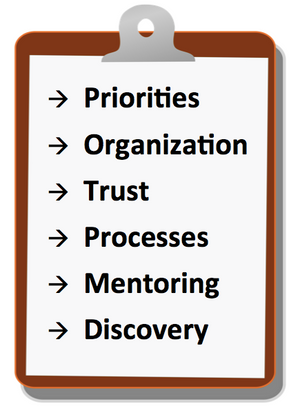Individual product managers drive individual products or services. VPs of Product Management establish the broader context for getting great products/services built and successful. They use a combination of processes, trust-building, hiring, mentoring and cross-functional leadership to help their individual product managers succeed. Since I spend most of my time wrangling product issues at the C-Level, here are some thoughts on creating conditions that can unleash great product/technical work.
For context, let’s imagine a newly arrived Vice President (or Director) of Products. She is taking over a product management team of 5, matched with a development organization of 50. Product roles are poorly defined, priorities are muddy, overall development productivity is uninspiring, and there’s lots of griping about how product management isn’t doing its job. What should our heroine put on her three-month strategic to-do list?
[1] Create and merchandise a minimalist current-quarter priority list. As quickly as possible, she needs a simple, force-ranked answer to “what are our top 3 product/market priorities this quarter?” This should be obvious, but rarely is. Even if only partly correct, such a list gives her a way to push consensus among the executive team – which will be critical to everything that follows. An astute negotiator, she gets Exec Staff’s agreement that her list is “right enough” and they will back her product priorities. She relentlessly shares this high-level list with her functional partners (Development, Sales, Marketing) to uncover any festering disagreements. [The list is less than a roadmap, and doesn’t address feature-level choices, but helps her sort “you don’t agree with my priorities” from “you think my team is failing.”]

[2] Become the heat shield for escalations. Our VP Product won’t be surprised that her team gets 5+ escalations every day from Sales, Support, customers and prospects. Each of these makes sense in a vacuum, and her individual product managers are spending a lot of their time defending the current plan from trainloads of seemingly good suggestions. She knows that Sales & Marketing live in an AND universe, but Development lives in an EXCLUSIVE OR universe. Her Product managers straddle the two.
Since she has buy-in to a few explicit priorities, her team can respond more clearly to other requests. “That’s a great idea, tell me more about the customer’s root issue… but we’ll need to put that into the backlog since it’s not one of our top two things for this quarter.” Lots of escalations will ricochet back to her, mostly from Sales, when she can stand firm on most of the account-specific requests that consume so much development time. She becomes the congenial promoter of EXCLUSIVE OR thinking at the executive level, freeing up her team to make more nuanced decisions.
[3] Create some job boundaries. She’s certain to discover that every department feels short-changed for product management attention. Steve Johnson calls this the “product janitor” syndrome where everyone gets to decide what product managers are supposed to do, and the combined list is impossible.
- Dev: “The scrum product owner book says that product managers must be at every standup and available to development teams 24*7. Every story needs to be exhaustive, and we need 4 sprints-worth of groomed backlog.”
- Sales: “Product managers must be on every new customer call and in every technical partnering meeting. Everyone at the company works in Sales.”
- Innovation/Lean Strategy Exec: “We need dual-track discovery teams of Product + UX + Technical Architecture in the field at all times.”
- Marketing: “Your team has to staff 6 industry events next quarter. And create 4 segment-specific product pitches. And do weekly webinars.”
- Support: “Incoming bugs need to be ranked and sized within a week.”
Her individual product managers don’t have enough organizational leverage to fight back this job scope creep, and they’ve inadvertently raised expectations by temporary filling gaps – only to inherit those gaps permanently. Our new VP Product needs to set some general guidelines for her team, which makes this less personal. (“I expect that you’ll each spend ~60% with Development; ~30% with customers, prospects and market discovery; and 10% with organizational communications/planning. Trade shows only if you’re speaking. No unqualified sales calls: only train-the-trainer and technical closer meetings. Let’s talk through where that’s challenging, and what I can take off your collective plates.”)
[4] Built trust, promote cross-functional good will, and “sell” the value of product management. Our VP will be frustrated (but not surprised) that almost no one at her company understands what product managers do, or how they really add value. Combined with the unbounded job expectations above, her team is often viewed as failing. So in her free time, she starts a slow-but-steady roadshow for her peers and their departments. This combines basic education (“here’s how my team helps us build the right products and make money”), active listening (“I’m sure things aren’t perfect. Let’s talk sort through your issues and pick one to address first”) and endless reiteration of priorities (“Here are our #1 and #2 deliverables for the quarter. Let me know if there’s anything you would put above #1.”) She’s building trust along the way: “selling” that her team isn’t rejecting enhancement requests out of spite, nor willfully avoiding meetings to set around and eat doughnuts. Her product managers have tons of responsibility but no authority, so they need cross-organizational trust to get anything done.
[5] Get Development re-energized. She probably hears some under-engaged development teams complaining about wasted work and erratic priorities. A student of Daniel Pink, she knows that we can not force developers to work harder, but we can motivate them. We can get them excited about problems and emotionally connected to users. We can shows devs that they are working on what really matters to paying customers. So our VP organizes product/vision sessions specifically for Development. (Key messages: “Real users have these problems. Product and Development collectively refine problem statements and collectively find solutions. We want the smartest people in the room to figure it out.”) Shockingly, engineers start working late because they love to solve meaningful problems.
[6] Update the hiring and training/mentoring plan. Our VP has repeatedly inherited untrained, unmentored product teams with the wrong skill sets and in the wrong geographies. She rips up the current hiring plan and job descriptions, which emphasize subject matter expertise over than product management experience. (“How hard could it be? Take the two-day CSPO class.”) She moves actual product experience to the top of her candidate filter, and requires that all new product hires be co-located with their development teams. Then she starts a weekly mentoring/coaching cycle with her current staff – emphasizing organizational collaboration and strategic market understanding. Not all of them are well suited for product management, but she’ll groom as many as she can. (And help find better-fitting roles in the company for the rest.)

[7] Organize market discovery teams. After a month of two, morale is up and escalations are down. Her product teams are starting to find their grooves. Now it’s time to start identifying what the broader market really wants from her product line. Our VP might partner with Development to form a part-time market validation team (her best product manager, a UX veteran and a software architect) to validate new product concepts with real B2B users. Or push for instrumentation and A/B testing of consumer SaaS improvements. Or oversee a few other Lean experiments. Exec-level air cover for these teams is critical, since her peers tend to value current-quarter deliverables above all else, and keep postponing real market learning for just another quarter or two.
That’s a lot to do! Good thing our heroine plays the long game: finding motivation in small wins and attitudinal improvements along the road to great products. And revenue. And cross-functional trust.
It’s worth noting that great product managers can work some of these issues for themselves (and their teams), but we want them to focus on their specific products/services. It’s very hard to drive organizational change while also building winning products.
Also: some Directors and VPs of Product are really player-coaches: managing a small part of the product portfolio themselves while overseeing a team. If you have more than 3 direct reports, though, you should be focused on this kind of organizational enablement and process improvement — which your staff can’t do for you. Delegate the product-specific work.
SOUND BYTE
Product management leaders/executives have to create an environment where their teams can be successful. That includes a lot of organizational design, behavior modification, and relentless focus on the few most important projects.

